The Monarda Guide
Monarda, commonly known as bee balm, is a vibrant, aromatic perennial prized for its showy flowers and pollinator appeal. Its shaggy, two-lipped blooms and minty-scented foliage bring a lively burst of color to summer gardens, attracting bees, butterflies, and hummingbirds in abundance. With cultivars spanning shades of red, pink, purple, and coral, monarda enlivens sunny borders and naturalistic plantings.
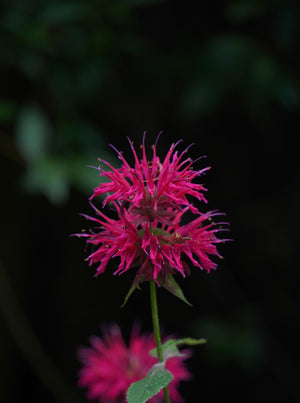
About
Monarda is a member of the mint family (Lamiaceae) and is native to North America. It includes several species—Monarda didyma, Monarda fistulosa, Monarda punctata, and Monarda bradburiana—each with distinct traits, but all known for their tubular flowers and fragrant foliage.
- Monarda didyma cultivars like 'Jacob Cline', 'Grand Parade', and 'Gardenview Scarlet' offer large, vibrant blooms in mid to late summer.
- The compact Balmy series—'Balmy Pink', 'Balmy Rose', and 'Balmy Purple'—is well-suited for containers and small spaces.
- The Leading Lady series—'Amethyst', 'Plum', 'Razzberry', and 'Orchid'—blooms earlier than traditional types.
- 'Claire Grace' and 'Purple Rooster' are known for mildew resistance and striking color.
- Unique selections like Monarda bradburiana 'Midnight Oil' or Monarda punctata (spotted bee balm) bring subtle pastels and layered bracts for added visual interest.
Popular cultivars such as 'Bubblegum Blast', 'Rockin’ Raspberry', and 'Raspberry Wine' have become staples in modern perennial gardens thanks to their long bloom periods and attractive growth habits.
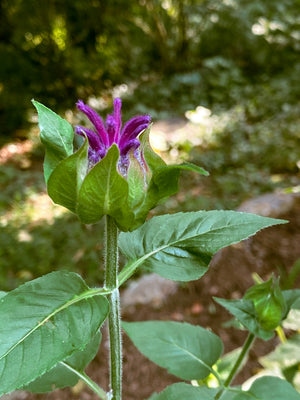
PLANTING
Monarda thrives in sunny, moist conditions and is easy to establish in garden beds or pollinator habitats:
- USDA Hardiness Zones: Hardy in Zones 4–9.
- Soil: Moist, well-drained, and rich in organic matter. Tolerates clay and loamy soils.
- Sunlight: Full sun is ideal, though light shade is tolerated in hot climates.
- Spacing: Space 18–24 inches apart to promote airflow and prevent powdery mildew.
- Planting Time: Spring or fall planting ensures strong root development.
To plant, dig a hole slightly larger than the root ball, place the plant at soil level, backfill, and water thoroughly. Apply mulch to retain moisture and suppress weeds.
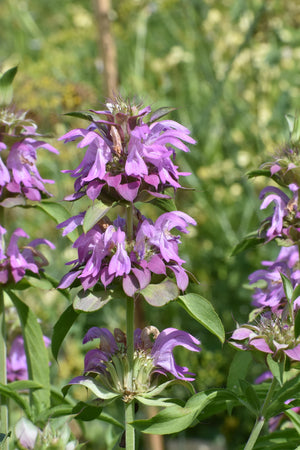
CARE
Monarda is a rewarding perennial that benefits from a few key cultural practices to ensure robust growth and flowering:
- Watering: Keep soil consistently moist but not soggy, especially during the flowering season. Avoid drought stress to prevent wilting and leaf scorch.
- Fertilizing: Apply compost or a slow-release balanced fertilizer in spring to support growth and blooms.
- Deadheading: Regularly remove spent flowers to encourage repeat blooming and prevent unwanted self-seeding.
- Pruning: Cut stems to the ground in late fall or early spring. Divide every 2–3 years to maintain vigor and reduce crowding.
- Disease Management: Choose mildew-resistant varieties and maintain good air circulation. Water at the base of the plant to reduce foliage wetness.
While monarda is not typically plagued by pests, watch for occasional issues with leafhoppers or powdery mildew in humid climates.
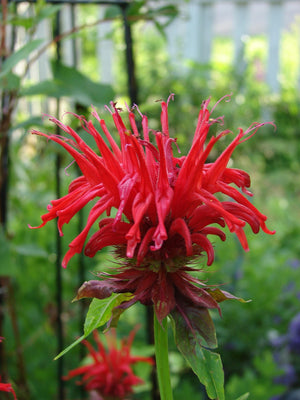
HOW TO USE
Monarda’s bold flowers, height, and fragrance make it a versatile addition to many garden designs:
- Pollinator Gardens: Monarda is essential for attracting bees, butterflies, and hummingbirds. Plant in clumps to maximize its impact.
- Meadow & Prairie Plantings: Mix with coneflower, rudbeckia, liatris, and ornamental grasses for a layered, natural look.
- Borders & Cottage Gardens: Use 'Cherry Pops', 'Electric Neon Coral', or 'Pardon My Purple' to add vibrant color to perennial beds.
- Containers: Compact types like 'Petite Delight' and 'Balmy Purple' bring color and fragrance to patios and balconies.
- Cut Flower Gardens: Long-lasting blooms and aromatic foliage make monarda a favorite for summer bouquets.
Pair bee balm with Russian sage, agastache, salvia, or echinacea to create high-performing, pollinator-friendly combinations.
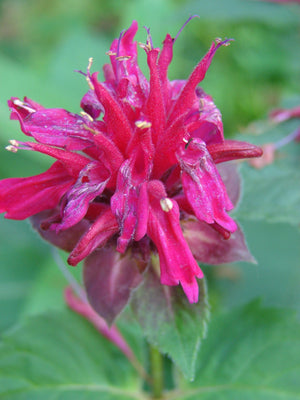
COMMON QUESTIONS
- Is monarda a perennial? Yes, monarda is a hardy herbaceous perennial that returns reliably each spring.
- Is monarda invasive? Some older cultivars and species like Monarda fistulosa can spread aggressively by rhizomes. Newer hybrids are more clump-forming and manageable.
- What to plant with monarda? Great companions include echinacea, rudbeckia, salvia, agastache, and ornamental grasses.
- Is monarda deer resistant? Yes, monarda is generally deer resistant due to its strong aroma and essential oils.
- Do you deadhead monarda? Yes, deadheading spent blooms encourages continued flowering and reduces unwanted self-seeding.
- How to care for monarda? Provide consistent moisture, full sun, and space plants well. Prune annually and divide every few years.
- Is monarda toxic to dogs? Monarda is not known to be toxic to dogs.
- Is monarda toxic to cats? Monarda is not considered toxic to cats.
Conclusion
Monarda adds a vibrant splash of color and movement to any sunny landscape, drawing in pollinators and adding vertical interest throughout summer. With cultivars ranging from compact to tall, and hues from deep red to lilac, bee balm offers flexibility for gardens of all styles and sizes. Easy to grow and maintain, it’s a must-have for creating dynamic, wildlife-friendly plantings.
The Monarda Collection
Sold Out
Sold Out
Sold Out
Sold Out






